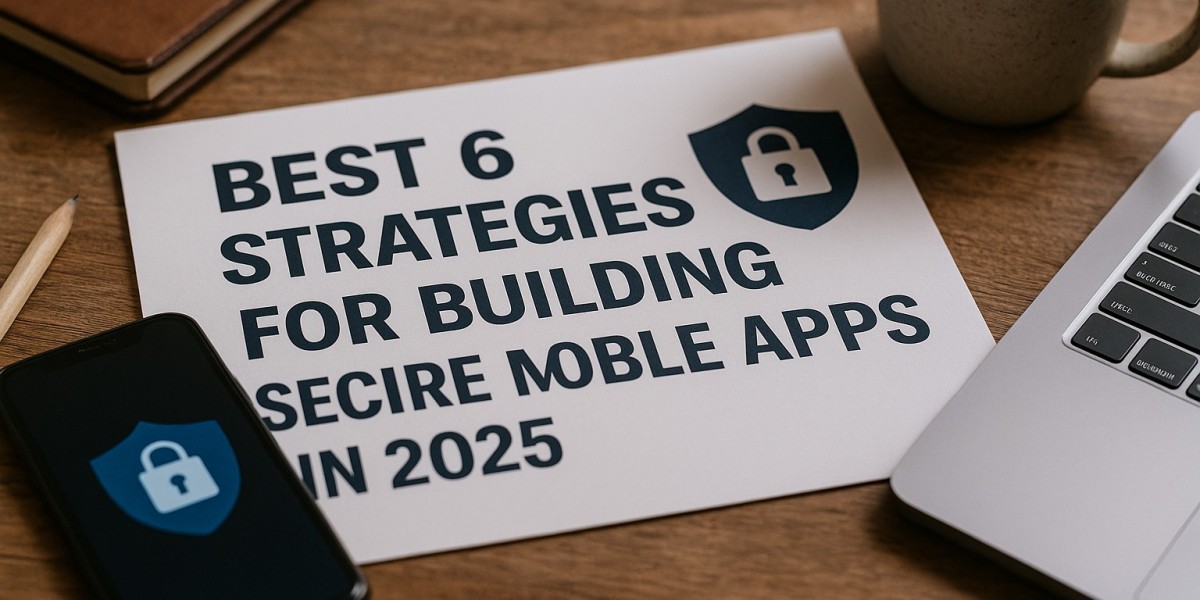As mobile applications become increasingly indispensable to daily life and business operations, the imperative for robust security has never been higher. With cyber threats constantly evolving, a Mobile App Development Company must adopt proactive and comprehensive strategies to safeguard user data, intellectual property, and app integrity. Building secure mobile apps in 2025 is not merely about patching vulnerabilities; it's about embedding security into every layer of the development lifecycle, from conception to continuous monitoring.
The digital landscape of 2025 demands a multi-faceted approach to mobile app security, moving beyond reactive measures to embrace a "security-first" mindset. Here are the top 6 strategies essential for building truly secure mobile applications.
1. Security-by-Design & Threat Modeling (Shift-Left Security)
The most effective security strategy begins long before a single line of code is written. "Security-by-Design" advocates for integrating security considerations into the initial planning and design phases of mobile app development. This "shift-left" approach identifies and mitigates potential vulnerabilities early, where they are far less costly and complex to fix.
What it entails:
Threat Modeling: Systematically identifying potential threats, vulnerabilities, and attack vectors in the app's architecture and features. This involves mapping out data flows, identifying entry points, and assessing potential risks (e.g., using methodologies like STRIDE - Spoofing, Tampering, Repudiation, Information Disclosure, Denial of Service, Elevation of Privilege).
Secure Architecture Design: Designing the app's components, modules, and interactions with security principles in mind, such as the principle of least privilege, defense in depth, separation of concerns, and secure default configurations.
Privacy by Design: Integrating data privacy protections into the app's design from the outset, ensuring compliance with regulations and user expectations regarding personal data handling.
Why it's crucial for 2025: Proactive security prevents fundamental architectural flaws that are expensive, if not impossible, to remediate later. As apps become more complex and interconnected (e.g., with IoT, AI services), anticipating attack surfaces at the design stage is paramount.
Implementation: Conduct regular security design reviews, involve security experts from the project's inception, and document security requirements alongside functional ones. A forward-thinking Mobile App Development Company prioritizes this foundational step.
2. Secure Coding Practices & Input Validation
Even the most robust design can be undermined by insecure coding practices. Developers must adhere to secure coding guidelines specific to mobile platforms (Android, iOS) and apply rigorous input validation to prevent common attack techniques.
What it entails:
Input Validation: Thoroughly validating all user input and data received from external sources (APIs, third-party libraries, files) to prevent injection attacks (SQL, XSS, command injection), buffer overflows, and other data manipulation vulnerabilities. This includes checking data type, length, format, and range.
Secure API Usage: Correctly using platform-specific security APIs (e.g., Android Keystore, iOS Keychain for secure storage; secure network protocols).
Error and Exception Handling: Implementing robust error handling mechanisms that fail securely and do not leak sensitive information to attackers or users.
Code Obfuscation & Tamper Detection: For critical code, applying obfuscation techniques to make reverse engineering harder, and implementing mechanisms to detect if the app's code has been tampered with.
Why it's crucial for 2025: Many breaches stem from basic coding errors or insufficient input validation. With automated attack tools becoming more sophisticated, even seemingly minor flaws can be exploited. Code obfuscation and tamper detection become more relevant as attackers target client-side logic and data.
Implementation: Establish clear secure coding standards and checklists, conduct regular peer code reviews focused on security, and utilize Static Application Security Testing (SAST) tools as part of the CI/CD pipeline to automatically detect insecure code patterns.
3. Robust Authentication, Authorization, and Session Management
Weak authentication and authorization mechanisms are consistently listed among the top mobile security risks. Ensuring that only legitimate users can access appropriate resources and that user sessions are handled securely is fundamental.
What it entails:
Multi-Factor Authentication (MFA): Implementing MFA (e.g., biometrics, OTPs via email/SMS, authenticator apps) for all sensitive actions, significantly increasing the difficulty for attackers to gain unauthorized access.
Strong Password Policies: Enforcing complex password requirements, discouraging common patterns, and encouraging regular changes (or better yet, transitioning to passwordless authentication like passkeys).
Secure Session Management: Using short-lived, unique session tokens that are stored securely, invalidated upon logout or inactivity, and protected against session hijacking (e.g., through proper token renewal and revocation mechanisms).
Role-Based Access Control (RBAC): Defining granular permissions based on user roles, ensuring users only have access to the data and functionalities necessary for their role (least privilege principle).
Centralized Authentication: Utilizing established identity providers (IdPs) and secure protocols (like OAuth 2.0, OpenID Connect) rather than building custom authentication systems, which are prone to errors.
Why it's crucial for 2025: Identity theft and unauthorized access remain primary attack vectors. The rise of sophisticated phishing and credential stuffing attacks makes robust authentication layers non-negotiable. Passwordless solutions are gaining traction for both security and user experience.
Implementation: Prioritize MFA for all user accounts. Regularly audit authentication and authorization flows. A reputable Mobile App Development Company leverages industry-standard authentication protocols and integrates secure SDKs for biometrics and passkeys.
4. Data Encryption (In Transit & At Rest) and Secure Storage
Protecting sensitive data, whether it's moving between the app and a server or stored locally on the device, is a cornerstone of mobile app security. Encryption renders data unreadable to unauthorized parties.
What it entails:
Encryption in Transit (HTTPS/TLS): All communication between the mobile app and backend servers must occur over secure, encrypted channels using HTTPS with properly configured TLS (Transport Layer Security) protocols. Certificate pinning should be considered to prevent Man-in-the-Middle (MitM) attacks.
Encryption At Rest (On-Device Storage): Sensitive data stored locally on the device (e.g., user preferences, cached data, tokens) must be encrypted. This includes using platform-provided secure storage mechanisms (e.g., Android Keystore, iOS Keychain) rather than insecure alternatives like SharedPreferences or NSUserDefaults.
Secure File Handling: Implementing secure practices for handling files, ensuring that temporary files, logs, and sensitive assets are not inadvertently exposed or accessible.
Key Management: Securely managing encryption keys, ensuring they are not hardcoded or easily discoverable within the app's codebase.
Why it's crucial for 2025: Data breaches are costly, both financially and reputationally. With increasing regulatory scrutiny (e.g., expanded data privacy laws), robust data encryption is not just a best practice but often a legal requirement.
Implementation: Automate TLS certificate validation. Enforce encryption for all sensitive data stored on the device. Conduct regular audits of data storage locations and encryption methodologies.
5. API Security & Server-Side Validation
Mobile apps rarely operate in isolation; they heavily rely on APIs to communicate with backend services. Securing these APIs is as critical as securing the app itself, as they often serve as the gateway to sensitive data and functionalities.
What it entails:
API Authentication & Authorization: Implementing strong authentication for API access (e.g., OAuth 2.0, JWTs) and ensuring granular authorization for API endpoints, restricting access based on user roles and permissions.
Input Validation on Server-Side: Re-validating all data received from the mobile app on the server-side, as client-side validation can be bypassed. This prevents malicious data from reaching backend systems.
Rate Limiting & Throttling: Implementing controls to limit the number of API requests from a single source to prevent brute-force attacks, DDoS (Distributed Denial of Service) attempts, and abuse.
OWASP API Security Top 10: Adhering to the OWASP API Security Top 10, which identifies the most critical API security risks (e.g., Broken Object Level Authorization, Broken User Authentication, Excessive Data Exposure).
API Gateway: Using an API Gateway to centralize security policies, handle authentication, rate limiting, and traffic management, providing an additional layer of defense.
Why it's crucial for 2025: APIs are a prime target for attackers due to their direct access to backend systems. As apps become more API-driven, securing these interfaces is paramount to preventing data breaches and unauthorized access.
Implementation: Treat all incoming API requests as untrusted. Implement robust logging and monitoring for API activity. A diligent Mobile App Development Company ensures backend APIs are secured with the same rigor as the mobile frontend.
6. Continuous Security Testing, Monitoring, and Supply Chain Security
Security is not a one-time event but an ongoing process. Mobile apps, like any software, require continuous vigilance, regular testing, and attention to the entire software supply chain to remain secure.
What it entails:
Static Application Security Testing (SAST): Analyzing source code without running the app to find vulnerabilities.
Dynamic Application Security Testing (DAST): Testing the running application from the outside to find vulnerabilities.
Interactive Application Security Testing (IAST): Combining SAST and DAST for more comprehensive analysis.
Penetration Testing (Pen-testing): Ethical hackers simulating real-world attacks to uncover vulnerabilities.
Vulnerability Scanning: Automated tools to identify known vulnerabilities in dependencies and the app itself.
Regular Security Testing: Conducting comprehensive security testing throughout the development lifecycle and post-deployment. This includes:
Continuous Monitoring & Incident Response: Implementing real-time monitoring of app usage for suspicious activity, unusual traffic patterns, or signs of compromise. Having a well-defined incident response plan to quickly detect, contain, and remediate security incidents.
Supply Chain Security: Verifying the security of all third-party libraries, SDKs, APIs, and open-source components used in the app. Regularly updating dependencies to patch known vulnerabilities and minimizing reliance on unmaintained or questionable external code.
Automated Security in CI/CD (DevSecOps): Integrating security checks, scans, and tests directly into the Continuous Integration/Continuous Delivery (CI/CD) pipeline, ensuring security is automated and continuous.
Why it's crucial for 2025: The threat landscape is dynamic. New vulnerabilities are discovered daily, and attackers constantly refine their methods. Automated security testing and continuous monitoring are essential for detecting and responding to emerging threats rapidly. Supply chain attacks (e.g., injecting malicious code into popular libraries) are a growing concern.
Implementation: Invest in automated security testing tools. Subscribe to security advisories for all third-party components. Conduct periodic external penetration tests. A proactive Mobile App Development Company implements a robust DevSecOps culture.
Conclusion
Building secure mobile applications in 2025 demands a proactive, holistic, and continuous approach. It's an ongoing commitment that spans every stage of the software development lifecycle, from initial design to post-deployment monitoring. By diligently applying strategies like security-by-design, robust coding practices, strong authentication, comprehensive data encryption, stringent API security, and relentless testing and monitoring, a dedicated Mobile App Development Company can significantly enhance the resilience of their mobile applications. In an era where mobile apps are central to business and personal lives, investing in these security measures is not just a best practice—it's an absolute necessity for protecting users, reputation, and the bottom line.







